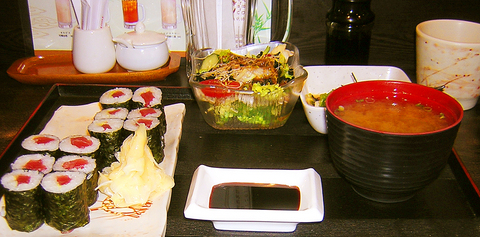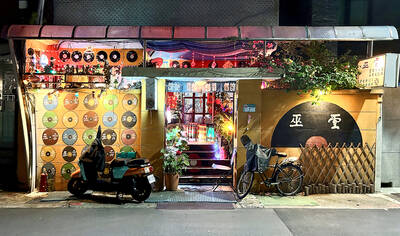Looking to explore Japanese food but don’t think you can settle on just one dish? Plan on eating with friends who have a hard time agreeing on what to order? Want to drink lots of alcohol and enjoy a good meal at the same time? This restaurant solves these dilemmas in one fell swoop.
Yabu Soba serves izakaya ryori (居酒屋料理), or pub-style food. Think of the rathskeller you visit for dinner, except this one serves Japanese dishes and you order a bunch of small but substantial courses to share with a group. There are tables in the back, with bamboo blinds and pictures of sumo wrestlers for decoration. In the evening things get lively and you can still eat at the bar, although this one offers a view of sake bottles and sushi preparation instead of whiskey and beer taps.
On a recent visit a party of seven shared seven delicious dishes and consumed several one-liter bottles of Kirin beer. The result was a satisfying meal and the tab came out at NT$450 per person. Impressively, staff offered to alter the portions of each dish to suit the size of our group.

PHOTO: RON BROWNLOW, TAIPEI TIMES
Memorable courses included the roast potato slices topped with mentaiko, or marinated roe, (NT$160, 烤馬鈴薯明太子), California rolls (NT$160, 加州酪梨捲) and beef tataki (NT$360, 日式生煎牛排), slices of raw steak that have been lightly seared on the outside and are to be dipped in a ponzu sauce. The sauce is what makes this dish. Stir in sliced ginger and scallions thoroughly before dipping the thinly sliced beef.
Staff also recommended the kimchee beef (NT$190, 韓國泡菜牛肉), chicken wings with mentaiko inside (NT$190, 烤雞翅包明太子), and the restaurant’s trademark soba noodles (NT$150, 日式蕎麥冷麵). There’s also a decent selection of vegetable and tofu dishes, such as fried tofu (NT$70, 炸豆腐) and spinach with egg (NT$130, 菠菜蛋); tell staff if you’re a vegetarian before ordering. This being an izakaya, there’s a drinks menu that features around a dozen brightly colored cocktails.
Yabu Soba moved from its old location on Linshen North Road four years ago. It’s now on Nanjing East Road next to the Emperor Hotel and three blocks east of the Zhongshan MRT station.
During lunchtime things are much more subdued and Yabu Soba looks more like a run-of-the-mill Taipei Japanese eatery, albeit one with an extensive and eclectic menu. Lunch prices run from NT$110 for soup noodles to NT$250 or more for a set meal with soup, salad and entree.

The Lee (李) family migrated to Taiwan in trickles many decades ago. Born in Myanmar, they are ethnically Chinese and their first language is Yunnanese, from China’s Yunnan Province. Today, they run a cozy little restaurant in Taipei’s student stomping ground, near National Taiwan University (NTU), serving up a daily pre-selected menu that pays homage to their blended Yunnan-Burmese heritage, where lemongrass and curry leaves sit beside century egg and pickled woodear mushrooms. Wu Yun (巫雲) is more akin to a family home that has set up tables and chairs and welcomed strangers to cozy up and share a meal

Dec. 8 to Dec. 14 Chang-Lee Te-ho (張李德和) had her father’s words etched into stone as her personal motto: “Even as a woman, you should master at least one art.” She went on to excel in seven — classical poetry, lyrical poetry, calligraphy, painting, music, chess and embroidery — and was also a respected educator, charity organizer and provincial assemblywoman. Among her many monikers was “Poetry Mother” (詩媽). While her father Lee Chao-yuan’s (李昭元) phrasing reflected the social norms of the 1890s, it was relatively progressive for the time. He personally taught Chang-Lee the Chinese classics until she entered public

Last week writer Wei Lingling (魏玲靈) unloaded a remarkably conventional pro-China column in the Wall Street Journal (“From Bush’s Rebuke to Trump’s Whisper: Navigating a Geopolitical Flashpoint,” Dec 2, 2025). Wei alleged that in a phone call, US President Donald Trump advised Japanese Prime Minister Sanae Takaichi not to provoke the People’s Republic of China (PRC) over Taiwan. Wei’s claim was categorically denied by Japanese government sources. Trump’s call to Takaichi, Wei said, was just like the moment in 2003 when former US president George Bush stood next to former Chinese premier Wen Jia-bao (溫家寶) and criticized former president Chen

President William Lai (賴清德) has proposed a NT$1.25 trillion (US$40 billion) special eight-year budget that intends to bolster Taiwan’s national defense, with a “T-Dome” plan to create “an unassailable Taiwan, safeguarded by innovation and technology” as its centerpiece. This is an interesting test for the Chinese Nationalist Party (KMT), and how they handle it will likely provide some answers as to where the party currently stands. Naturally, the Lai administration and his Democratic Progressive Party (DPP) are for it, as are the Americans. The Chinese Communist Party (CCP) is not. The interests and agendas of those three are clear, but